From obliterating asteroids to nudging space trash, lasers in space are becoming every bit as futuristic as they sound.
Lasers in space have long been a science-fiction writer’s delight, but with current projects such as LightForce and DE-STAR on the horizon, reality could become every bit as fantastic as fiction.
It was a clear morning on Feb. 15, 2013, when a terrific fireball streaked across the sky in central Russia. Witnesses testified to hearing an explosion and seeing a blinding light, followed by feeling the shudder of the shockwave as a meteor crashed in Russia’s Ural Mountains in the Chelya-binsk region.
The meteor injured around 1000 people, as the shockwave blew out windows and rocked buildings. The incredible sight was caught by numerous cameras and uploaded onto Internet video-sharing websites within minutes.
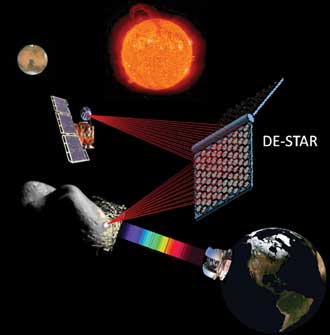
A concept diagram of an orbiting DE-STAR engaged in multiple tasks, including asteroid diversion, composition analysis and long-range spacecraft power and propulsion. Photo courtesy of Philip Lubin, UC Santa Barbara
Surely it was a one-in-a-million incident? An event no one expects and no one can predict or prevent? The truth is, about 100 tons of meteoric material hits us every day – mostly small bits that burn up in the atmosphere – but once in a while we can expect a meteor the size of the one that hit Chelyabinsk, or even larger, to streak into our everyday lives.
Philip Lubin and colleagues in the physics department at the University of California, Santa Barbara (UCSB), presented a possible solution to asteroids that threaten the Earth at the Planetary Defense Conference this past April.
The system is called DE-STAR (Directed Energy Solar Targeting of Asteroids and exploRation). DE-STAR’s bold mission is to use focused laser energy to raise the surface-spot temperature of an asteroid to over 3000 K, allowing direct evaporation of all known substances.
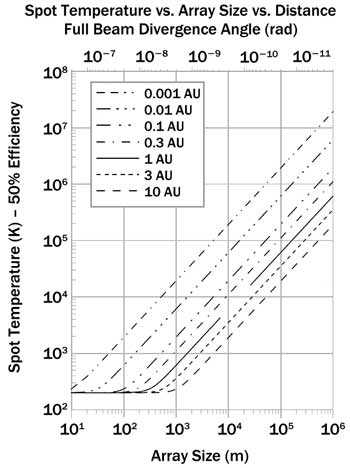
Spot temperature versus DE-STAR array size for various target distances. Photo courtesy of Philip Lubin, UC Santa Barbara
As if obliterating the surface of the asteroid wasn’t enough, the UCSB team says that the material ejected from the asteroid would create a large-enough reaction force to alter the asteroid’s orbit, thus protecting the Earth from its collision course.
DE-STAR would orbit the Earth as a kind of space soldier, armed and ready to protect the planet from interstellar threats. The idea may have raised a few eyebrows, but Lubin is the first to cast a critical eye over the out-of-this-world laser system.
“I think ‘audacious’ is a good term I heard recently,” Lubin said. “Anything new and out of the box should get lots of skepticism. This is healthy. I am a very skeptical (in science) person myself. I have a list of my top 100 worries that I am going through.
“I have not met anyone yet who is asking tougher questions than I am of myself. I am not interested in fantasy, only in what is physically possible, even if difficult.”
DE-STAR will consist of ytterbium-doped fiber laser amplifiers at 1.06 µm that are seeded and hence phase-locked by a common seed laser (master oscillator).
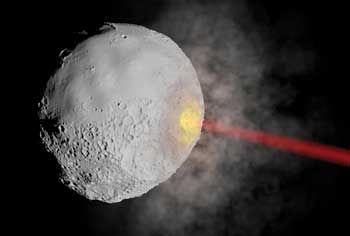
Visualization with relevant physical phenomena included.
The plume density is exaggerated to show ejecta. Courtesy of Philip
Lubin, UC Santa Barbara
Deploying DE-STAR in space allows the coherent beam to be unhindered by atmospheric fluctuations and to receive its
power from the sun. Modular design allows for incremental development, test and initial deployment – lowering cost, minimizing risk and allowing for technological co-development, leading eventually to an orbiting structure that could be erected in stages.
Virtually all planetary exploration today is driven using chemical propellants. While this method has proved to be extremely successful, it is also extremely limited in its future potential. These rockets require vast amounts of fuel primarily used during launch, resulting in minimal gain in speed after leaving the Earth’s atmosphere.
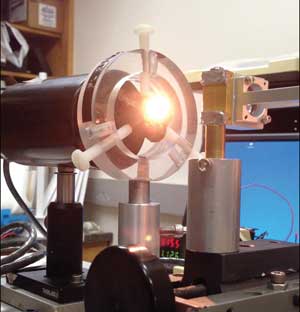
A laser fires at a basalt target during laboratory testing of DE-STAR. Photo courtesy of Philip Lubin, UC Santa Barbara
DE-STAR, however, would directly use the laser system in a photon drive
similar to a “solar sail” system, which could provide enough energy not
only to safeguard the Earth from asteroids but also for space
exploration.
“This is a project where … you look at the current state of the art and the progression coming and ask, ‘What is the fundamental limit for such a system, based on known physics and based on current and projected technology?’ ” Lubin said. “I do not need any miracles. You will come to the conclusion, I believe, that: Yes, such a system or something similar will be built. It is too compelling not to do so, as it can be used for many purposes besides asteroid mitigation.”
Lasers tackle space debris
It’s not just Earth that needs protection from collisions; we have launched billions of dollars’ worth of cutting-edge technology into orbit, including satellites, telescopes and the huge International Space Station (ISS), and there is real concern for the safety of this equipment from the threat of space debris collisions.
Earth’s orbit is becoming increasingly crowded. Low Earth orbit (LEO) in particular is littered with dead satellites, spent booster stages and innumerable other debris. Some estimates suggest that there are approximately 11,000 objects with a diameter larger than 30 cm; 100,000 objects with a diameter between 10 and 30 cm; and millions of smaller objects in orbit.
Each of these objects poses a serious risk to current operations in space – and if nothing is done, the problem could get much worse. The fear is that each collision could create more potentially damaging debris, triggering a chain reaction of collisions until a critical point is reached and the amount of orbital debris increases exponentially.
This is known as the Kessler Syndrome – proposed by NASA scientist Donald Kessler in 1978 – in which we reach a state where space exploration and operation are rendered impossible due to huge debris belts orbiting the Earth.
“If not mitigated, the problem of collisions with orbital debris in space will continue to damage and destroy satellites – and other space missions, like the ISS – in Earth orbit,” said Creon Levit, chief scientist for programs at NASA Ames Research Center in California. “With each collision producing thousands of new pieces of space debris, the result over the long term (around 100 years) could make space operations and space travel impossible.”
Some reports suggest that this could already be under way and that stabilizing the LEO environment at current levels would require the ongoing removal of at least five large debris objects per year going forward.
LightForce is a project devised at the NASA Ames Research Center as a novel way to prevent collisions in orbit using photon pressure alone. Using a medium-powered ground-based laser in combination with a ground-based telescope, debris would be nudged out of the way of a collision.
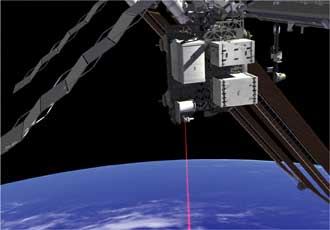
OPALS will demonstrate video-data streaming for about 100 seconds as the International Space Station travels over the ground telescope on Table Mountain, Calif. Photo courtesy of NASA
Applying laser light over multiple engagements could slow or prevent the orbital debris cascade from taking place and provide protection for satellites that lack onboard propulsion.
“Our proposal nudges debris, using momentum from a laser beam generated on the Earth, so as to avoid impending collisions,” Levit said. “All large debris and satellites are tracked already, and when close approaches (conjunctions) are predicted, a couple of LightForce stations on the ground, each consisting of a 10- to 15-kW laser and a 1- to 2-m telescope, illuminate the debris as it passes overhead. The momentum imparted to the debris, in this way, can change its orbit sufficiently to avoid the predicted collision.”
Laser to transmit video from space
OPALS (Optical Payload for Lasercomm Science) – a NASA flight system that will demonstrate optical communication by transferring video back down to Earth – is scheduled for launch to the ISS on the next commercial resupply flight.
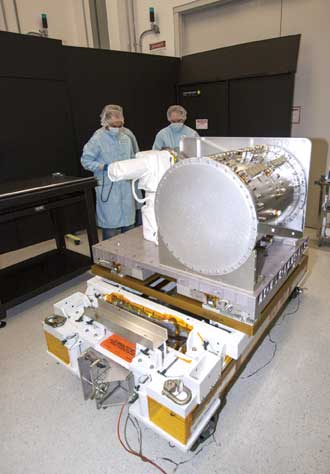
OPALS is uncovered at NASA’s Kennedy Space Center in Florida. Set for launch next month, the mission
is expected to run 90 days after installation on the outside of the ISS. Photo courtesy of Jim Grossmann, NASA
OPALS represents the next big leap in telecommunication carrier frequency from the conventional radio frequency to the optical regime, which promises to improve NASA’s data rates for communications with future spacecraft by a factor of 10 to 100.
“Historically, the demand for improved service has been met by stepping through higher carrier frequencies in the radio-frequency spectrum,” said OPALS principal investigator Abi Biswas. “For example, space telecommunication systems have evolved through L-, S-, X- and K-bands. Even with K-band data rates, streaming high-definition imagery from high-resolution space instruments that can generate gigabits per second of uncompressed data becomes prohibitively difficult and demanding on mass, power and volume resources on spacecraft.”
OPALS will be mounted on the outside of the ISS and communicate with the Optical Communications Telescope Laboratory at the Jet Propulsion Laboratory facilities on Table Mountain in Wrightwood, Calif.
As the ISS travels across the sky, a laser beacon will be transmitted from the ground telescope to the ISS and tracked. While maintaining lock on the uplink beacon using a closed-loop control system and a two-axis gimbal, the OPALS flight system will downlink a modulated laser beam with a formatted video. Each demonstration will last about 100 seconds as the ISS and ground telescope maintain line of sight.
“By demonstrating the ability to reliably exchange narrow laser beams between Earth and fast slew-rate spacecraft under varying conditions, the path to the future implementation of high-data-rate, low-mass, power and volume optical communication systems will be paved,” Biswas said.
The next big milestone will be to support NASA’s upcoming Laser Communication Relay Demonstration in the next two or three years.
In another NASA venture set to demonstrate the remarkable powers of laser communication is the Lunar Laser Communication Demonstration (LLCD), launched on board the Lunar Atmosphere and Dust Environment Explorer in September. Incredibly, the LLCD mission will be NASA’s first high-rate, two-way space laser communication demonstration that will downlink data to the Earth from the moon – 1000 times farther than the ISS.